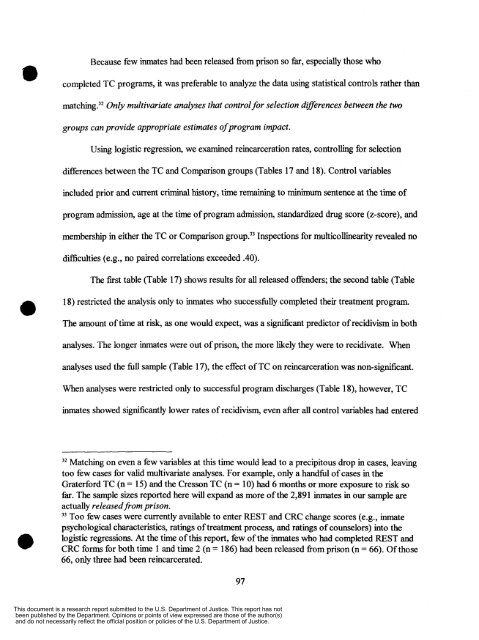0 - National Criminal Justice Reference Service
0 - National Criminal Justice Reference Service
0 - National Criminal Justice Reference Service
You also want an ePaper? Increase the reach of your titles
YUMPU automatically turns print PDFs into web optimized ePapers that Google loves.
Because few inmates had been released fiom prison so far, especially those who<br />
completed TC programs, it was preferable to analyze the data using statistical controls rather than<br />
matching.32 Only multivariate analyses that control for selection differences between the two<br />
groups can provide appropriate estimates of program impact.<br />
Using logistic regression, we examined reincarceration rates, controlling for selection<br />
differences between the TC and Comparison groups (Tables 17 and 18). Control variables<br />
included prior and current criminal history, time remaining to minimum sentence at the time of<br />
program admission, age at the time of program admission, standardized drug score (2-score), and<br />
membership in either the TC or Comparison<br />
Inspections for multicollinearity revealed no<br />
difficulties (e.g., no paired correlations exceeded .40).<br />
The first table (Table 17) shows results for all released offenders; the second table (Table<br />
18) restricted the analysis only to inmates who successfblly completed their treatment program.<br />
The amount of time at risk, as one would expect, was a significant predictor of recidivism in both<br />
analyses. The longer inmates were out of prison, the more likely they were to recidivate. When<br />
analyses used the fU sample (Table 17), the effect of TC on reincarceration was non-significant.<br />
When analyses were restricted only to successhl program discharges (Table 1 8), however, TC<br />
inmates showed significantly lower rates of recidivism, even after all control variables had entered<br />
0<br />
32 Matching on even a few variables at this time would lead to a precipitous drop in cases, leaving<br />
too few cases for valid multivariate analyses. For example, only a handfbl of cases in the<br />
Graterford TC (n = 15) and the Cresson TC (n = 10) had 6 months or more exposure to risk so<br />
far. The sample sizes reported here will expand as more of the 2,891 inmates in our sample are<br />
actually released from prison.<br />
33 Too few cases were currently available to enter REST and CRC change scores (e.g., inmate<br />
psychological characteristics, ratings of treatment process, and ratings of counselors) into the<br />
logistic regressions. At the time of this report, few of the inmates who had completed REST and<br />
CRC forms for both time 1 and time 2 (n = 186) had been released fiom prison (n = 66). Of those<br />
66, only three had been reincarcerated.<br />
97<br />
This document is a research report submitted to the U.S. Department of <strong>Justice</strong>. This report has not<br />
been published by the Department. Opinions or points of view expressed are those of the author(s)<br />
and do not necessarily reflect the official position or policies of the U.S. Department of <strong>Justice</strong>.
















